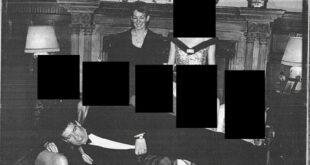Bridget Lawson, centre, worked in Africa in later life for AMREF, a non-governmental organization that provides health care in East Africa. From 1984 to 1990, she was executive director of AMREF Canada and travelled to Africa twice a year.Courtesy of the Family
The Second World War first altered the life of 15-year-old English schoolgirl Bridget Gregson (later known by her married name, Lawson) when she was evacuated from her boarding school in southern England and sent to Canada for safety along with her three younger siblings. Three years later, she graduated from high school and joined the Royal Canadian Navy to help in the war effort. She was sent to Halifax, where she worked as a decoder, and in May of 1945, she and a colleague saw the message sent to German U-boat crews to surface and surrender to the nearest Allied port.
She remained in Canada and died in Toronto on Oct. 29 at the age of 97.
Bridget Elizabeth Gregson was born in Knaresborough, North Yorkshire, England, on June 11, 1925. Her father, Donald Gregson, was an officer with the British Army in India, then part of the British Empire, and her mother, Violet (née Hanson), travelled home to England to give birth. When Bridget was two, she, her mother and her younger sister returned to Pune (then known as Poona), in India, and the family went back to England in 1932.
Her father then went to work for the family coffee firm. He rejoined the army at the start of the war and was part of the evacuation from France at Dunkirk in late May and early June of 1940. Lieutenant Gregson feared for the safety of his four children, as they were living in Dorset near the coast, and the children were sent to Canada later that year.
“The grown-ups seemed to talk about nothing but war and how England could be invaded by Germany,” Bridget wrote in a memoir of the period.
The 10-day Atlantic crossing was on the RMS Duchess of Atholl, a Canadian Pacific ocean-liner converted to a troop carrier. The hope was that the fast vessel could outrun the German U-boats. It made that trip safely but was sunk by a German submarine in 1942; four crew members died, but all others aboard were rescued.
Bridget said she and her sister, Hilary, were in a tiny cabin down in E Deck that smelled oily and where she could hear the constant hum of the engines.
“Each day, we would have a lesson about Canada, our new home, and so we learned the names of the provinces, the capitals and best of all, the words to O Canada and The Maple Leaf Forever!” She marvelled at the forests along the shore of the Gulf of St. Lawrence, then the cultivated fields and “lovely little farmhouses.”
“We stood by the railing as we landed in Montreal and were thrilled to see the docks lined with Mounties in splendid red coats, just like their pictures we thought,” she wrote. “Beautiful women in Red Cross uniform[s] stood inside the building with trays of orange juice and biscuits for us.”
:format(jpeg)/cloudfront-us-east-1.images.arcpublishing.com/tgam/VKJIYVSQPZHJHDSTFCRRDNPZSE.jpg)
Bridget Lawson during World War II, in 1944.Courtesy of the Family
As soon as Bridget arrived in Canada, she was sent to summer camp in Algonquin Park. She loved it.
“It was the beginning of bonding with Canada,” said her daughter Hilary, who was named after her aunt. “My mother loved the Canadian outdoors and the informal way of life.”
Bridget and her sister went to Branksome Hall, a private school in Toronto, and her brothers, Michael and Richard, went to Upper Canada College.
At 18, she joined the Royal Canadian Navy and moved to Halifax. She worked as a decoder, which she said required quite a bit of math, and she soon mastered it.
“They were trying to decode messages that gave the position of German U-boats in the North Atlantic,” her son Hugh said. “She said that it was one of the best times in her life, and she felt she made a contribution, however small, towards the war effort.”
Ms. Lawson never spoke in detail of her work in Halifax, her children say, probably because of a promise of secrecy.
Bridget left Halifax in August of 1945 and returned to Toronto, where she enrolled in the University of Toronto. In February of 1946, she went on a skiing trip to St. Sauveur, in the Laurentians north of Montreal, where she met Bill Lawson, a law student. They married in October of that year.
She helped put him through law school and they eventually moved to Pickering Village, now Ajax. Mr. Lawson commuted to a law firm in Toronto for a while but opened a practice in Pickering Village. Ms. Lawson was active in the community; she was the head of the Oshawa Children’s Aid Society and helped establish the Oshawa Art Gallery. The family had a cottage on Lake Kasshabog, then another at Stoney Lake. Life was idyllic, but Mr. Lawson died in 1971 when he was just 47.
By this time, Ms. Lawson had four children. The two older children were by then young adults and living on their own, and in 1973, Ms. Lawson and her two younger children set off for Malawi in East Africa. Before she left, she took a course in silk screening at Sheridan College because part of her work there would be in a silk screening shop. For two years, she worked for the Christian Service Committee in Malawi. She said it was: “The beginning of my lifelong love affair with Africa.”
When she returned to Canada, she started working for AMREF, a non-governmental organization that provides health care in East Africa. From 1984 to 1990, Ms. Lawson was executive director of AMREF Canada; she travelled to Africa twice a year.
“Bridget … served as a catalyst in helping to set up the McMaster Community Health Training Course in 1987 by connecting Dr. Chris Wood [one of the founders of AMREF] with the relevant personnel at CIDA [the Canadian International Development Agency],” wrote Nora Wilson, an AMREF board member.
In 1990 Ms. Lawson married John Duncanson, a long-time friend, and moved to Mono Township, north of Toronto. There she returned to the rural life of her first marriage and was an avid gardener, joined a mediation group, took a writing course and was involved in the Dufferin Arts Council. She also continued her involvement in several African projects.
Ms. Lawson leaves her brother, Michael; her children, Hugh, Hilary and Emily; stepchildren, Susan, John and Bob; 17 grandchildren and many great-grandchildren. Her son Nick died in 2019, and her husband, Mr. Duncanson, died in 2016.
Source link


